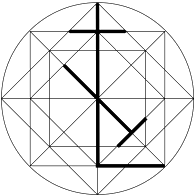
|
Art and Mathematics before the Quattrocento: A Context for Understanding Renaissance Architecture |
|---|
Department of Mathematical Sciences
Sweet Briar College
Sweet Briar, Virginia 24595 USA
In his classic Architectural Principles in the Age of Humanism, Rudolf Wittkower convincingly argues that an understanding of the roots of Renaissance architecture designed by masters such as Alberti and Palladio can be developed only by appreciating the relationships between architecture, music and mathematics as seen through the eyes of Renaissance architects and theorists. Crucial to developing this appreciation is the ability approach the world of knowledge as Renaissance scholars would have, without inherently accepting the artificial division of this world into arts and sciences-and the compartmentalized disciplines within each.
Lionel March suggests "…the Renaissance might be called the era of conspicuous erudition in which patrons, scholars, and artists displayed their breadth of classical learning in various works and commissions." The foundation of learning upon which artists of the Renaissance built was constructed through a determined search for reason in aesthetics, logic in beauty and rational explanations to intangible phenomena, a search involving at least implicit use of mathematics.
 This present paper
briefly discusses Neolithic speculative geometry; the beginnings
of history in the Middle East; the Greeks, first true mathematicians;
the Romans, masters of engineering; and the Middle Ages. In the
years immediately preceding the Renaissance, the qualitative
view of neo-Platonic metaphysics slowly gave way to a more quantitative
view of reality that would eventually allow science to progress
at a steady pace. This transition was slow, and Renaissance scholars
were still heavily influenced by long-held ideas on number symbolism
and sacred geometry.
This present paper
briefly discusses Neolithic speculative geometry; the beginnings
of history in the Middle East; the Greeks, first true mathematicians;
the Romans, masters of engineering; and the Middle Ages. In the
years immediately preceding the Renaissance, the qualitative
view of neo-Platonic metaphysics slowly gave way to a more quantitative
view of reality that would eventually allow science to progress
at a steady pace. This transition was slow, and Renaissance scholars
were still heavily influenced by long-held ideas on number symbolism
and sacred geometry.
As did their predecessors, Renaissance artists sought to incorporate meaning into their design by using a rational approach towards aesthetics. Some of the most prominent theorists -- Barbaro, Pacioli, and Dürer -- focused their efforts largely on concerns of geometry and proportion, often doing so within the context of the ideas described in this paper. Indeed, this was completely natural before the divorce of arts and sciences in the Age of Reason! It is crucial, therefore, to be able to put oneself in this same context if one is truly to understand Renaissance architecture.
ILLUSTRATION: Stonemason's mark from the Cathedral of Strasburg.
ABOUT
THE AUTHOR
Stephen
R. Wassell is
an Associate Professor of Mathematical Sciences at Sweet Briar
College in Virginia (USA). He has received a Bachelor of Science
degree in Architecture, a Ph.D. in Mathematics, and a Master's
degree in Computer Science from the University of Virginia. After
publishing several articles in his doctoral research area, mathematical
physics, he is now studying the relationships between architecture
and mathematics. At present, Steve's primary focus is on Palladian
architecture, since its roots--Palladio's own architecture, his
Quattro Libri, and the scholarly interests of his intellectual
circle--exhibit on an obvious appreciation of the mathematical
underpinnings of aesthetics. (This work has been partially supported
by a grant from the Graham
Foundation for Advanced Studies in the Fine Arts as well
as numerous grants from Sweet Briar College.) Steve's overall
mission is to explore and extol the mathematics of beauty and
the beauty of mathematics. He is the author of "The Mathematics
of Palladio's Villas Workshop '98", now available in the
NNJ volume 1 in print, and the review of Branko
Mitrovic's translation of Giacomo Barozzi
Da Vignola, Canon of the Five Orders of Architecture. He presented "The
Mathematics of Palladio's Villas" at Nexus 98, published
in Nexus
II: Architecture and Mathematics.
|
Stephen R. Wassell, "Art and Mathematics Before the Quattrocento: A Context for Understanding Renaissance Architecture", pp. 157-168 in Nexus III: Architecture and Mathematics, ed. Kim Williams, Pisa: Pacini Editore, 2000. http://www.nexusjournal.com/conferences/N2000-Wassell.html |
|
|
|
|
